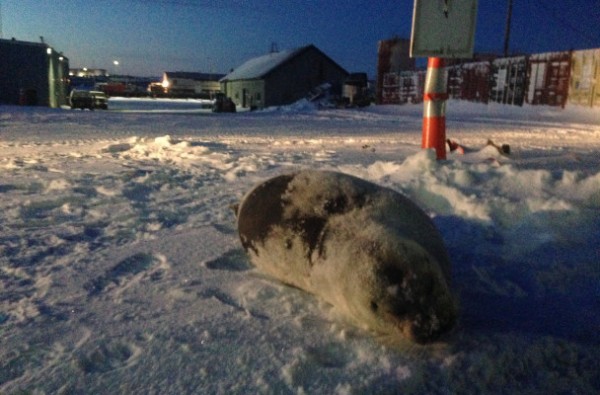Friday evening a seal made its way out of Nome’s iced-in port and up into the west side of town. Although it showed some physical signs of sickness, on Saturday local experts ultimately decided to release the seal back into the wild.

Besides looking a little patchy and out of place in the snow-covered parking lot on Nome’s west side of town, there didn’t seem to be anything usual about the bearded seal. Brandon Ahmasuk explains that the recent arrival of sea ice might help explain the stranding.
“At the end of the port, about a week ago, the ice hadn’t come in yet so it was our belief that it was just hanging out right inside the port on the ice and then that ice, the sea ice, came in and blocked off it’s exit.”
Ahmasuk is the Subsistence Director for Kawerak as well as the Bering Strait Commissioner for the Ice Seal Commission, two roles that prepare him for strandings such as this one.
In the case of a marine mammal stranding, there are three options: release the animal back into the wild, harvest it for subsistence, or send it down to the Alaska SeaLife Center in Seward, which handles marine mammal rehabilitation.
Although this particular seal wasn’t acting unusually, the region does have a history of seal sickness. Gay Sheffield, who works for the University of Alaska Fairbanks Alaska Sea Grant, is Nome’s local stranding responder and was one of the first on the scene. She explains the unusual mortality event, or UME, that struck the region in 2011.
“The seals had poor body conditions. They wouldn’t move out of peoples’ way. They had many more physical problems, internally and externally. They had sores, there was problems inside them. Since then we haven’t seen conditions like that but we do keep seeing seals that have lost their ability to grow their coat properly.”
With its patchy coat being one of it only symptoms, Sheffield and Ahmasuk decided against shipping it down to Seward. But, as Ahmasuk explains, it was that same symptom discouraged locals from harvesting the seal.
“I mean, we did ask around town other subsistence users if they wanted it and they said no, we don’t. Subsistence users, they’re pretty leery about harvesting something that they don’t even know what’s causing it. If they ingest it is that disease going transfer over to us?”
Sheffield says it’s been an uphill battle to figure out exactly what’s been preventing seals from growing a proper coat. She says there’s a long list of diseases they’ve eliminated, but still haven’t pinpointed one to explain it all.
The seal spent Friday night at Nome’s Public Safety Building and after observing its behavior, ultimately both Sheffield and Ahmasuk agreed on what to do next.
“It was feisty, it was fat, it wanted to be left alone. So the decision was made to release it.”
Using a large fish tote donated by the Norton Sound Economic Development Corporation, the seal was brought back down to beach. Along with needing extra hands to move the tote with the 200-pound seal, local hunters helped determine the best place to release it.
“The seal was released off of west beach and sea ice conditions were not terribly stable, but the guys who released it, the marine mammal hunters, are extremely knowledgeable in ice conditions.”
Sheffield went back to the beach the following day, where she says there were at least four seals hauled out on the sea ice. She described it as a “good ending for our unexpected visitor.”
Emily Russell is the voice of Alaska morning news as Alaska Public Media’s Morning News Host and Producer.
Originally from the Adirondacks in upstate New York, Emily moved to Alaska in 2012. She skied her way through three winters in Fairbanks, earning her Master’s degree in Northern Studies from UAF.
Emily’s career in radio started in Nome in 2015, reporting for KNOM on everything from subsistence whale harvests to housing shortages in Native villages. She then worked for KCAW in Sitka, finally seeing what all the fuss with Southeast, Alaska was all about.
Back on the road system, Emily is looking forward to driving her Subaru around the region to hike, hunt, fish and pick as many berries as possible. When she’s not talking into the mic in the morning, Emily can be found reporting from the peaks above Anchorage to the rivers around Southcentral.




